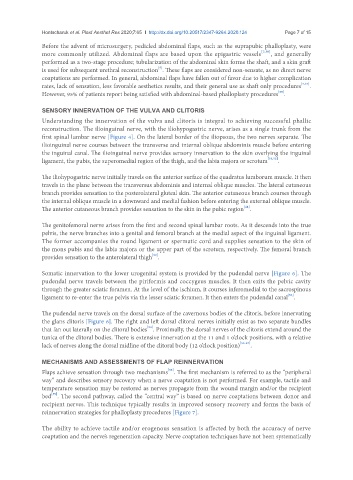Page 770 - Read Online
P. 770
Hontscharuk et al. Plast Aesthet Res 2020;7:65 I http://dx.doi.org/10.20517/2347-9264.2020.124 Page 7 of 15
Before the advent of microsurgery, pedicled abdominal flaps, such as the suprapubic phalloplasty, were
more commonly utilized. Abdominal flaps are based upon the epigastric vessels [7,50] , and generally
performed as a two-stage procedure; tubularization of the abdominal skin forms the shaft, and a skin graft
[7]
is used for subsequent urethral reconstruction . These flaps are considered non-sensate, as no direct nerve
coaptations are performed. In general, abdominal flaps have fallen out of favor due to higher complication
rates, lack of sensation, less favorable aesthetics results, and their general use as shaft only procedures [7,37] .
[50]
However, 95% of patients report being satisfied with abdominal-based phalloplasty procedures .
SENSORY INNERVATION OF THE VULVA AND CLITORIS
Understanding the innervation of the vulva and clitoris is integral to achieving successful phallic
reconstruction. The ilioinguinal nerve, with the iliohypogastric nerve, arises as a single trunk from the
first spinal lumbar nerve [Figure 4]. On the lateral border of the iliopsoas, the two nerves separate. The
ilioinguinal nerve courses between the transverse and internal oblique abdominis muscle before entering
the inguinal canal. The ilioinguinal nerve provides sensory innervation to the skin overlying the inguinal
ligament, the pubis, the superomedial region of the thigh, and the labia majora or scrotum [51,52] .
The iliohypogastric nerve initially travels on the anterior surface of the quadratus lumborum muscle. It then
travels in the plane between the transversus abdominis and internal oblique muscles. The lateral cutaneous
branch provides sensation to the posterolateral gluteal skin. The anterior cutaneous branch courses through
the internal oblique muscle in a downward and medial fashion before entering the external oblique muscle.
[44]
The anterior cutaneous branch provides sensation to the skin in the pubic region .
The genitofemoral nerve arises from the first and second spinal lumbar roots. As it descends into the true
pelvis, the nerve branches into a genital and femoral branch at the medial aspect of the inguinal ligament.
The former accompanies the round ligament or spermatic cord and supplies sensation to the skin of
the mons pubis and the labia majora or the upper part of the scrotum, respectively. The femoral branch
[52]
provides sensation to the anterolateral thigh .
Somatic innervation to the lower urogenital system is provided by the pudendal nerve [Figure 6]. The
pudendal nerve travels between the piriformis and coccygeus muscles. It then exits the pelvic cavity
through the greater sciatic foramen. At the level of the ischium, it courses inferomedial to the sacrospinous
[53]
ligament to re-enter the true pelvis via the lesser sciatic foramen. It then enters the pudendal canal .
The pudendal nerve travels on the dorsal surface of the cavernous bodies of the clitoris, before innervating
the glans clitoris [Figure 6]. The right and left dorsal clitoral nerves initially exist as two separate bundles
[54]
that fan out laterally on the clitoral bodies . Proximally, the dorsal nerves of the clitoris extend around the
tunica of the clitoral bodies. There is extensive innervation at the 11 and 1 o’clock positions, with a relative
lack of nerves along the dorsal midline of the clitoral body (12 o’clock position) [55-57] .
MECHANISMS AND ASSESSMENTS OF FLAP REINNERVATION
[58]
Flaps achieve sensation through two mechanisms . The first mechanism is referred to as the “peripheral
way” and describes sensory recovery when a nerve coaptation is not performed. For example, tactile and
temperature sensation may be restored as nerves propagate from the wound margin and/or the recipient
bed . The second pathway, called the “central way” is based on nerve coaptations between donor and
[59]
recipient nerves. This technique typically results in improved sensory recovery and forms the basis of
reinnervation strategies for phalloplasty procedures [Figure 7].
The ability to achieve tactile and/or erogenous sensation is affected by both the accuracy of nerve
coaptation and the nerve’s regeneration capacity. Nerve coaptation techniques have not been systematically

